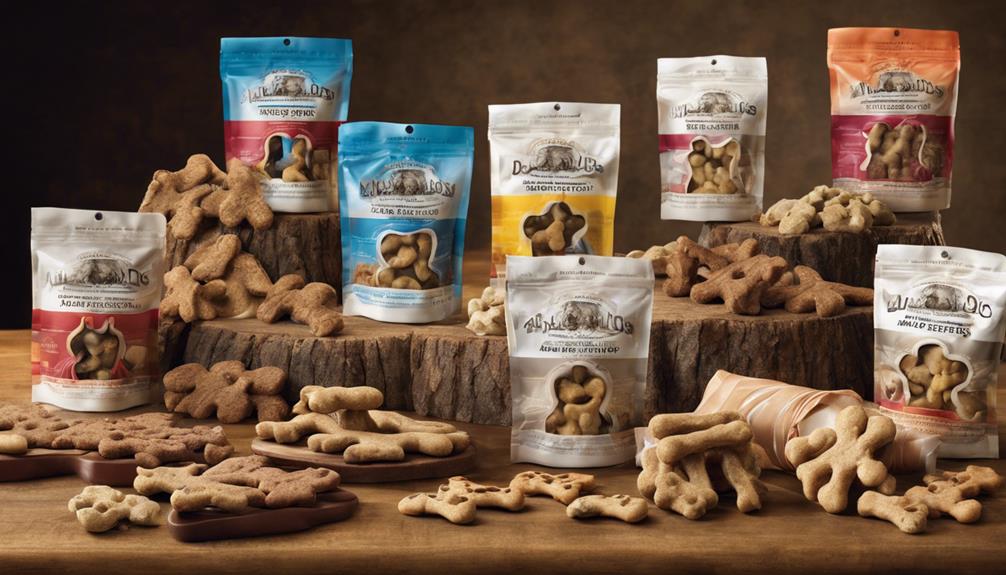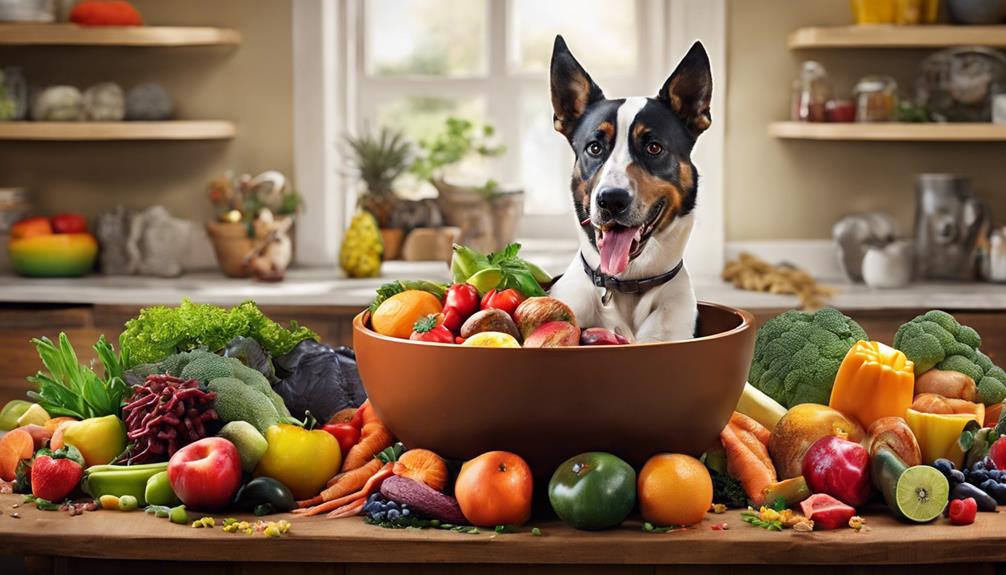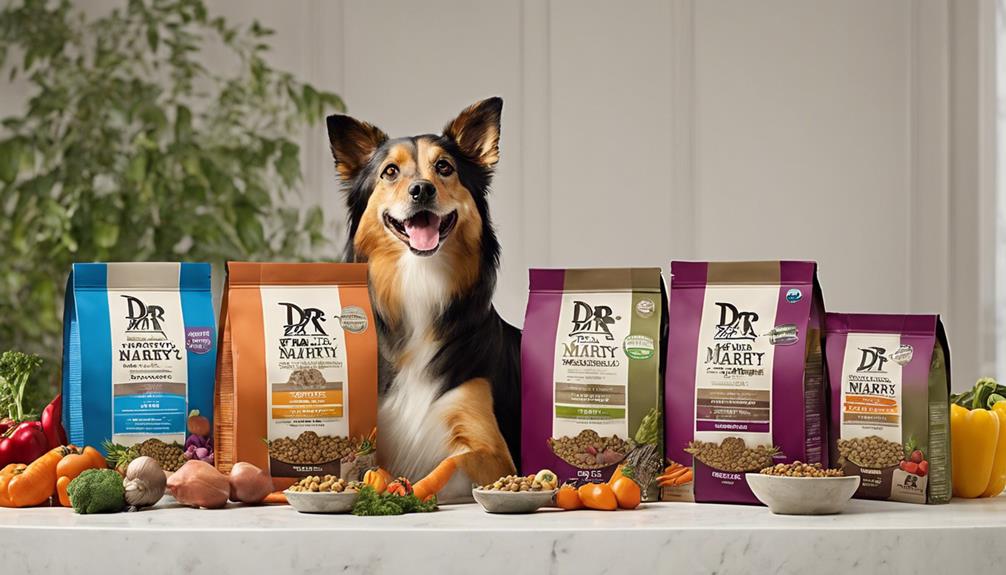When training your dog with good treats, it is important to remember that positive reinforcement is key. Choose rewards that will encourage the behaviors you desire and help strengthen your bond with your furry friend. In order to be successful, make sure to give treats promptly after good behavior, stay consistent, and use high-quality treats. Starting with simple commands such as “sit” or “stay” and eventually reducing the use of treats as behaviors improve are crucial steps in the training process. Avoid common errors like overusing treats and focus on gradually reducing their reliance. Each of these principles lays the groundwork for better comprehension and implementation of effective training techniques.
Key Takeaways
- Use high-quality treats for effective reinforcement.
- Timing and consistency are crucial in treat training.
- Gradually phase out treats as behaviors are mastered.
- Start with easy commands and high-value treats.
- Avoid common mistakes like excessive luring with treats.
Importance of Positive Reinforcement
When training with good dog treats, the importance of positive reinforcement can't be overstated. Positive reinforcement is a fundamental aspect of training that involves rewarding your dog for exhibiting desired behaviors. By using treats as rewards, you can effectively reinforce obedience, strengthen the bond between you and your furry companion, and enhance responsiveness. Food-motivated dogs, in particular, respond well to this form of reinforcement training.
Through enjoyable learning experiences that involve treats as rewards, your dog will be motivated to follow commands and engage in training sessions. This approach not only leads to better obedience but also fosters a deeper connection between you and your pet.
Studies have shown that food rewards are more effective than other forms of reinforcement, such as social interaction, in shaping behaviors during training sessions. By incorporating positive reinforcement with dog training treats, you can create a positive and rewarding environment that promotes learning and good behavior.
Utilizing Treats for Rewards
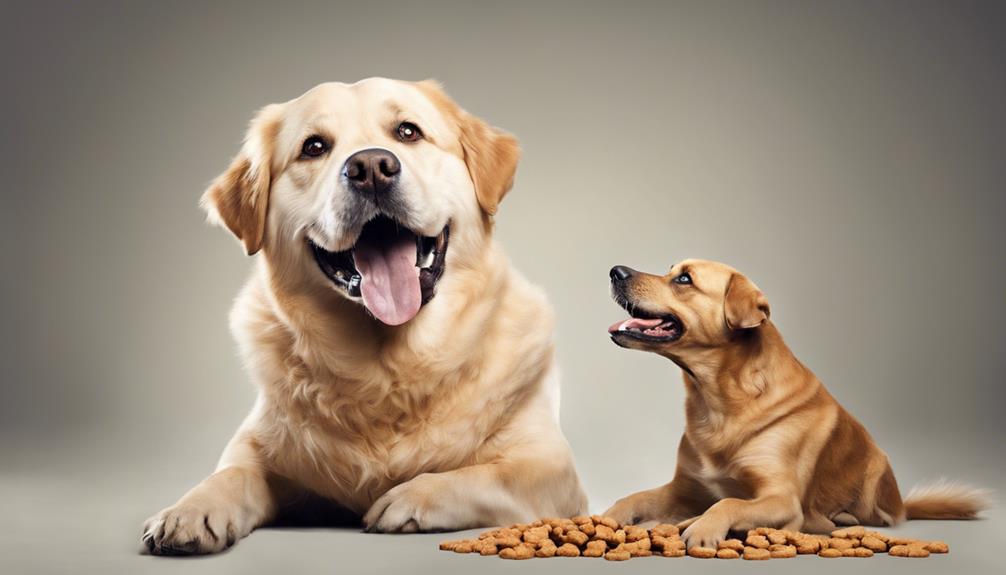
To effectively utilize treats for rewards in dog training, it's essential to understand the significance of timing and consistency in reinforcing desired behaviors. Here are key points to help you master this aspect of training:
- Immediate Reward Delivery: Providing the treat right after your dog displays the desired behavior reinforces the action effectively, linking the treat directly to the behavior.
- Consistent Reinforcement: Consistency in treating for good behavior is important. By rewarding the behavior every time it occurs, you help solidify the learning process and promote obedience.
- Building a Strong Bond: Using treats as rewards not only motivates your dog but also strengthens the bond between you and your furry friend. The positive association formed through treats fosters a deeper connection, making training sessions enjoyable for both of you.
Factors in Successful Treat Training
When training your dog with treats, remember that the quality of the treat is vital for success. Make sure you offer rewards promptly after the desired behavior, and be consistent in your timing to reinforce the connection between action and reward.
Providing a variety of treats can keep your pup motivated and excited to learn, ensuring effective training sessions.
Treat Quality Importance
The quality of dog treats greatly influences the success of training by directly impacting your pet's motivation and reinforcement. When considering treat quality for effective training, keep in mind the following key factors:
- High-Quality Ingredients: Opt for treats made with real meat or natural ingredients, as they're more appealing and enticing for your dog during training sessions.
- Speed and Accuracy: Quality treats can enhance the speed and accuracy of learning new behaviors, leading to more efficient training outcomes.
- Bond Strengthening: Investing in good dog treats not only improves obedience but also strengthens the bond between you and your furry companion, making the training experience more enjoyable and fruitful.
Timing and Consistency
How important is the timing and consistency in treat training for successfully shaping your dog's behavior?
Timing plays a critical role in treat training, as the reward must be given promptly after the desired behavior to reinforce it effectively.
Consistency in treat delivery is equally essential; it helps your dog associate the treat with the correct behavior, leading to quicker learning and retention.
By ensuring proper timing and consistency, you establish a clear link between the behavior and the reward, enhancing the training process.
Delayed treat delivery or inconsistent timing can confuse your dog, making it harder for them to understand which behavior is being rewarded.
Mastering timing and consistency in treat training enables you to shape your dog's behavior effectively and reinforce positive actions.
Variety for Motivation
To maintain your dog's motivation during training sessions, incorporating variety in treats is essential for keeping them engaged and interested. Here are three crucial points to ponder for successful treat training:
- Catering to Individual Preferences: Different textures, flavors, and types of treats cater to your dog's unique likes and dislikes, enhancing their training experience.
- Preventing Habituation: Rotating between high, medium, and low-value treats helps prevent habituation, ensuring your dog stays consistently motivated throughout the training process.
- Customization for Effectiveness: Offering a variety of treats allows for customization based on the training environment, distractions, and specific behaviors, helping you identify the most effective rewards for your dog's learning style and behavior.
Best Dog Treats for Training
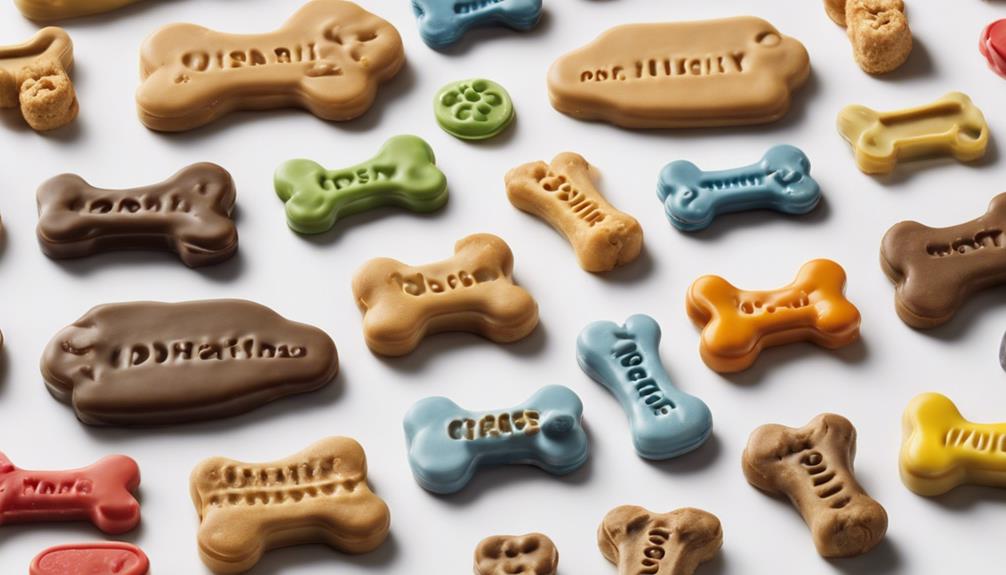
When training your dog, it's essential to select the best treats for effective results. High-value options like turkey hotdog and string cheese work well for teaching new behaviors and handling distractions.
Medium-value treats such as Zukes Mini Naturals and Redbarn Cheese Protein Puffs are perfect for reinforcing learned behaviors during training sessions.
Top Training Treats
When engaging in training sessions with your dog, selecting the best dog treats is essential for effective results. Here are some top training treats to ponder:
- Full Moon Organic Training Treats: Ideal for small dogs, these treats offer a high-quality training reward option.
- Zukes Mini Naturals: These low-calorie treats are excellent for training sessions and maintaining motivation.
- Redbarn Naturals Protein Puffs: With treats under one calorie, they're perfect for frequent rewards during training.
Choosing the right treats that cater to your dog's size and training needs can make a significant difference in their learning process. Remember, a tasty and motivating training reward can enhance your dog's focus and progress during training sessions.
Effective Reward Options
Considering your dog's training progress and motivation levels, selecting the best dog treats plays an important role in effective rewards during training sessions.
High-value treats like turkey hotdog and plain chicken work well for challenging behaviors and distractions, while medium-value treats such as Zukes Mini Naturals and Redbarn Cheese Protein Puffs are ideal for maintaining learned behaviors.
Low-value treats like FirstMate dry food and IMK9 Mutt Love Coconuts dry treats are suitable for encouraging good behavior in low-distraction environments.
Rotating treats and conducting taste tests can help identify your dog's preferences for different value treats.
Choosing the right treats based on their value is essential for effective training and for keeping your dog motivated and focused.
How to Identify Favorite Treats
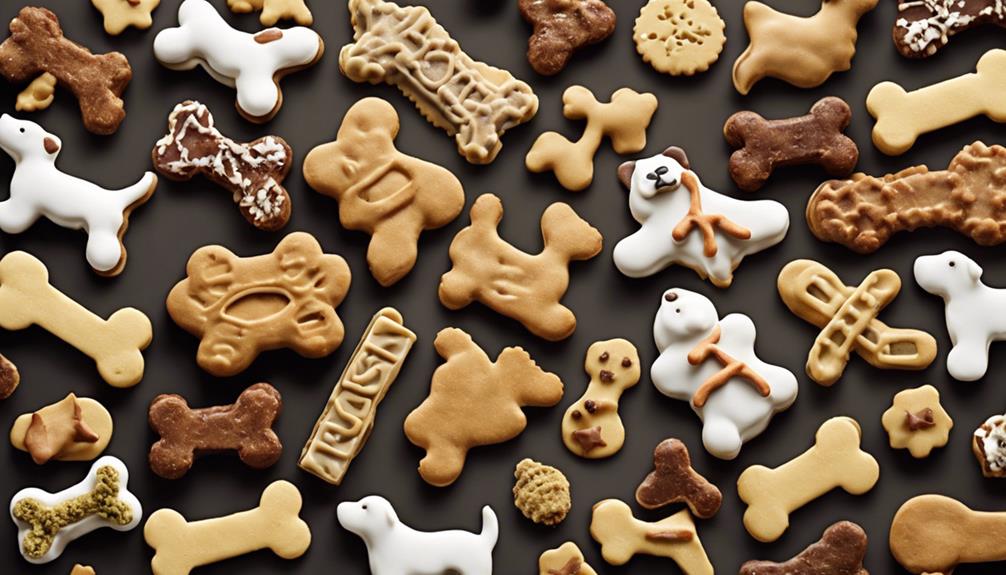
To pinpoint your dog's favorite treats, conduct a taste test with a variety of options to determine their preferences based on flavor, texture, and protein type.
- Allow your dog to choose between various treat options to determine high, medium, and low-value preferences.
- Rotate treats regularly to maintain motivation and prevent treat aversion in your dog.
- Experiment with different treat types such as smelly, moist high-value treats or dry, crunchy low-value treats to see what your dog responds to best.
Pay attention to your dog's reactions and engagement level with different treats to gauge their preferences accurately. By engaging in this taste test and observing your dog's reactions closely, you'll be able to identify the treats that truly excite and motivate your furry friend during training sessions.
Starting Training With Easy Commands
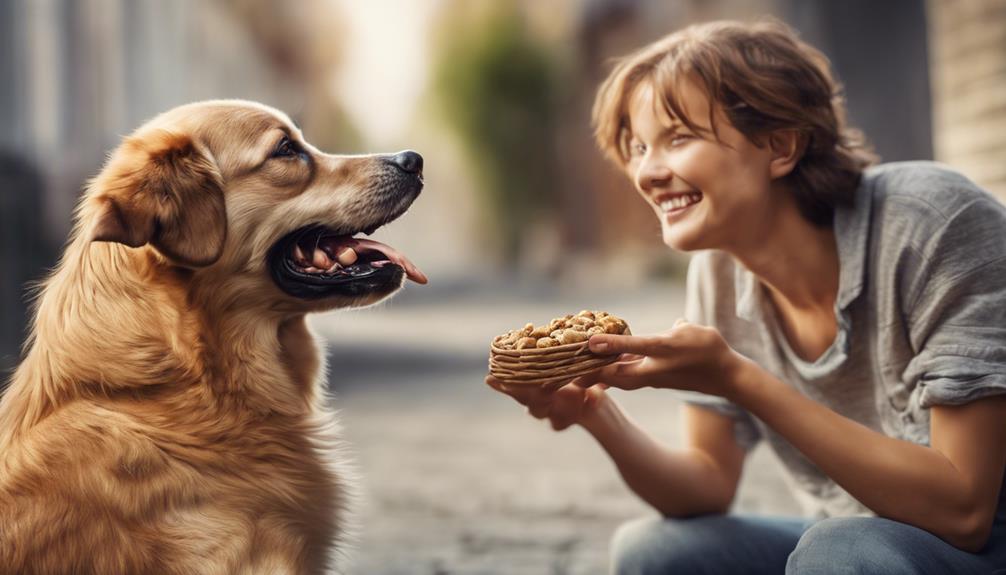
Begin training your dog by introducing basic commands such as 'sit' or 'stay' using high-value treats to motivate and reinforce the desired behavior. Keep the training sessions short to maintain engagement and prevent boredom while ensuring consistency in your commands and rewards. Essential reinforcement is vital in teaching your dog the basic commands effectively.
As your dog progresses, gradually increase the difficulty of the commands while still using treats for motivation. This progression in difficulty helps in building a strong foundation for more advanced training in the future. Remember, the key to successful training is to stay consistent and patient.
Consistency in Rewarding Behaviors
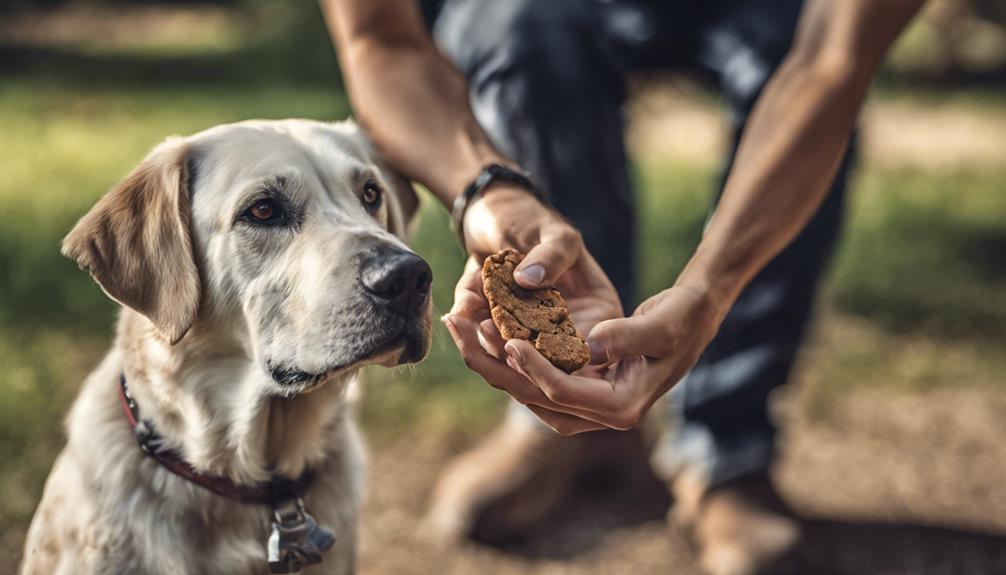
After introducing basic commands like 'sit' or 'stay' with high-value treats in your training sessions, ensuring consistency in rewarding behaviors is essential to reinforcing your dog's understanding and encouraging desired actions. Consistency helps your dog form positive associations and learn effectively.
Here's how to master rewarding behaviors:
- Immediate Treat Delivery: Reward your dog promptly after displaying the desired behavior. This instant reinforcement helps them connect the action with the treat.
- Create Routine and Predictability: Dogs thrive on routine, so establish a consistent pattern in your training sessions. Predictability helps your dog understand what's expected of them.
- Encourage Repetition: By consistently rewarding behaviors with treats, you encourage your dog to repeat those actions. Repetition is vital for solidifying learning and ensuring your dog continues to exhibit desired behaviors consistently in the future.
Phasing Out Treats Gradually
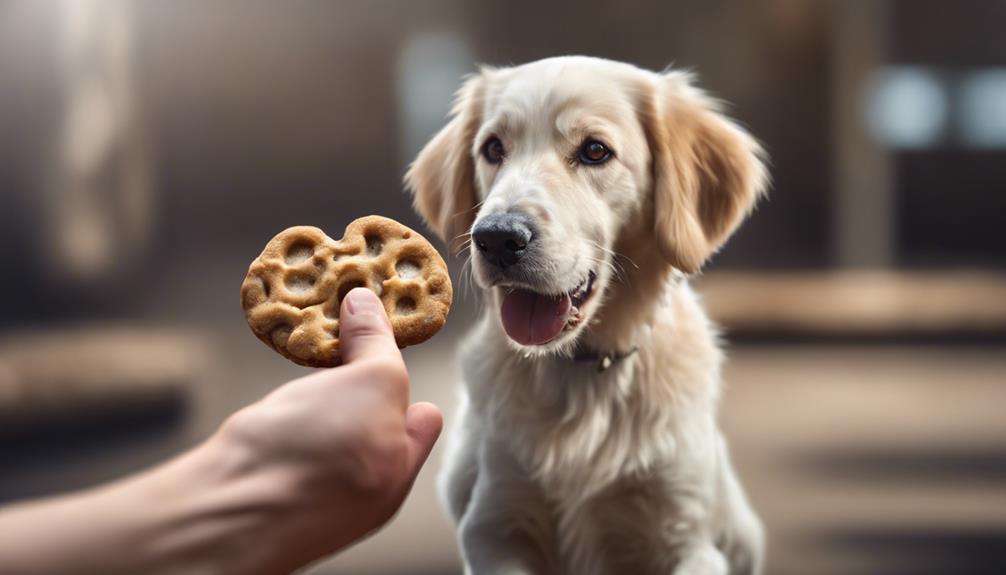
Gradually decreasing reward frequency as your dog masters behaviors is crucial to preventing reliance on treats for obedience. By gradually phasing out treats, you can cultivate a more intrinsic motivation in your furry companion. Increase gaps between reward distributions to promote consistent performance even without immediate reinforcement. This change helps your dog grasp that good behavior results in positive outcomes beyond just treats. Swap food rewards with other types of reinforcement like verbal praise, physical affection, or play. This shift helps your dog connect good behavior with various rewards, making training more interactive. Implement varied reinforcement schedules, sporadically rewarding behaviors to uphold learned responses over time. Utilize environmental rewards such as access to toys, walks, or social interactions to replace food treats during training sessions. Embrace this approach to uphold sustained performance and a comprehensive training experience for your canine companion.
| Progression Steps | Examples |
|---|---|
| Gradually decrease reward frequency | 1 treat every 3 commands |
| Increase gaps | Treat every 5 commands |
| Use alternative rewards | Verbal praise, playtime |
| Implement varied schedules | Reward unpredictably |
Common Mistakes in Treat Training

Avoid falling into the trap of luring your dog with treats during training sessions, as this can create dependency and hinder their learning progress. When it comes to training treats, remember these key points to prevent common mistakes:
- Treat Sizing: Opt for pea-sized treats to guarantee effectiveness without risking overfeeding, maintaining your dog's focus during training.
- Portion Control: Lack of portion control can diminish the value of treats as rewards, impacting the outcomes of your training sessions. Be mindful of the quantity you use.
- Strategic Use: Employ treats strategically to reinforce good behavior. This practice is crucial for consistency in training, preventing confusion, and ensuring your dog understands which behaviors lead to rewards.
Frequently Asked Questions
What Do Professional Dog Trainers Use for Treats?
For treats, professional dog trainers use high-value options like turkey hotdog and plain chicken. They also rely on medium-value treats like Zukes Mini Naturals. Low-value treats such as FirstMate dry food are great for encouraging good behavior.
Are Treats a Good Way to Train Dogs?
Yes, treats are a good way to train dogs. They serve as positive reinforcement for desired behaviors, helping dogs learn new tasks, improve obedience, and strengthen the bond with their owners. Giving treats promptly after actions reinforces training effectively.
Can I Use Dog Food as Treats for Training?
You can use dog food as treats for training. Make sure it's of high quality, easy to chew, and won't upset your dog's tummy. It's cost-effective and convenient, but monitor calories to avoid weight gain. Keep mastering those training sessions!
How to Make High-Value Dog Training Treats?
To make high-value dog training treats, choose protein-rich options like turkey hotdog or plain chicken. Keep them smelly, moist, and rare outside training for maximum appeal. Rotate treats to maintain excitement and effectiveness in training sessions.
What Are the Best Dog Treats to Use for Training?
When it comes to effective dog treats training, master the use of small, tasty rewards that can be easily consumed by your pup. Look for treats with high value, like small pieces of cooked chicken or freeze-dried liver. Remember to use treats sparingly to maintain your dog’s motivation.
Conclusion
To sum up, mastering training with good dog treats is essential for shaping your furry friend's behavior. By consistently rewarding positive actions with tasty treats, you can reinforce desirable behaviors and build a strong bond with your pet.
Remember, using the right treats and staying consistent are key factors in successful training. With patience and dedication, you can train your dog effectively and enjoy a well-behaved companion for years to come.
